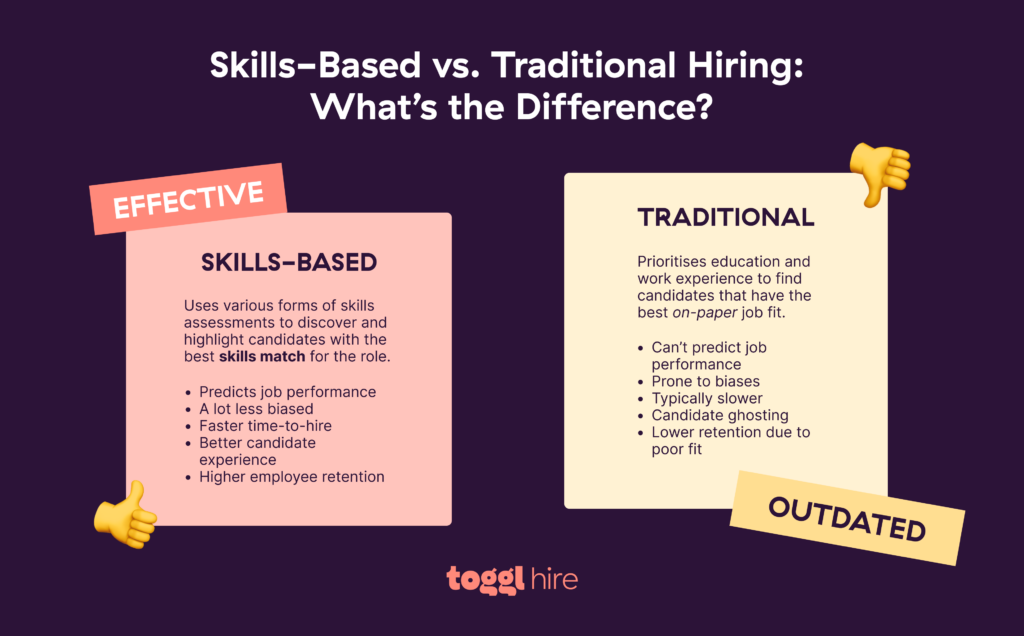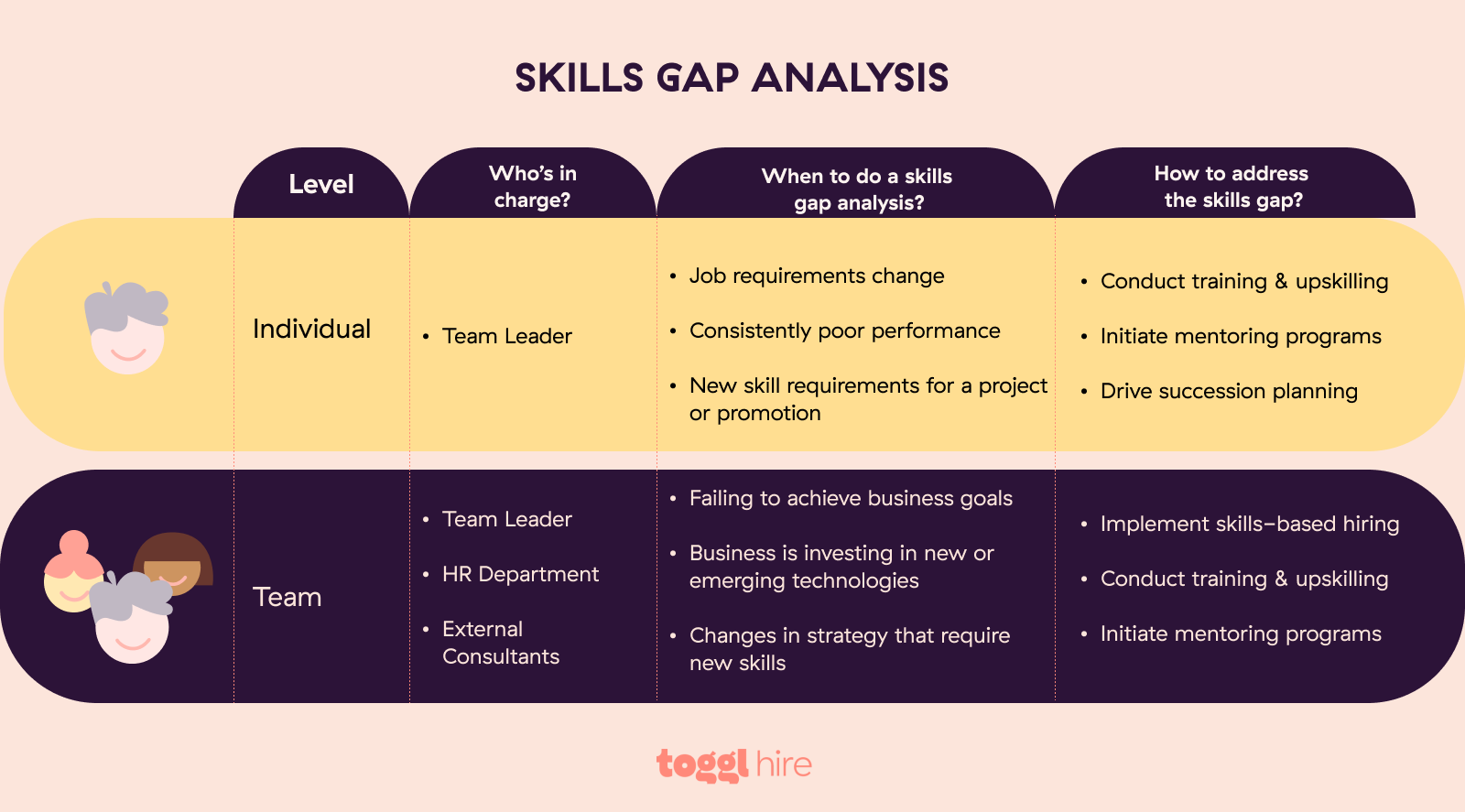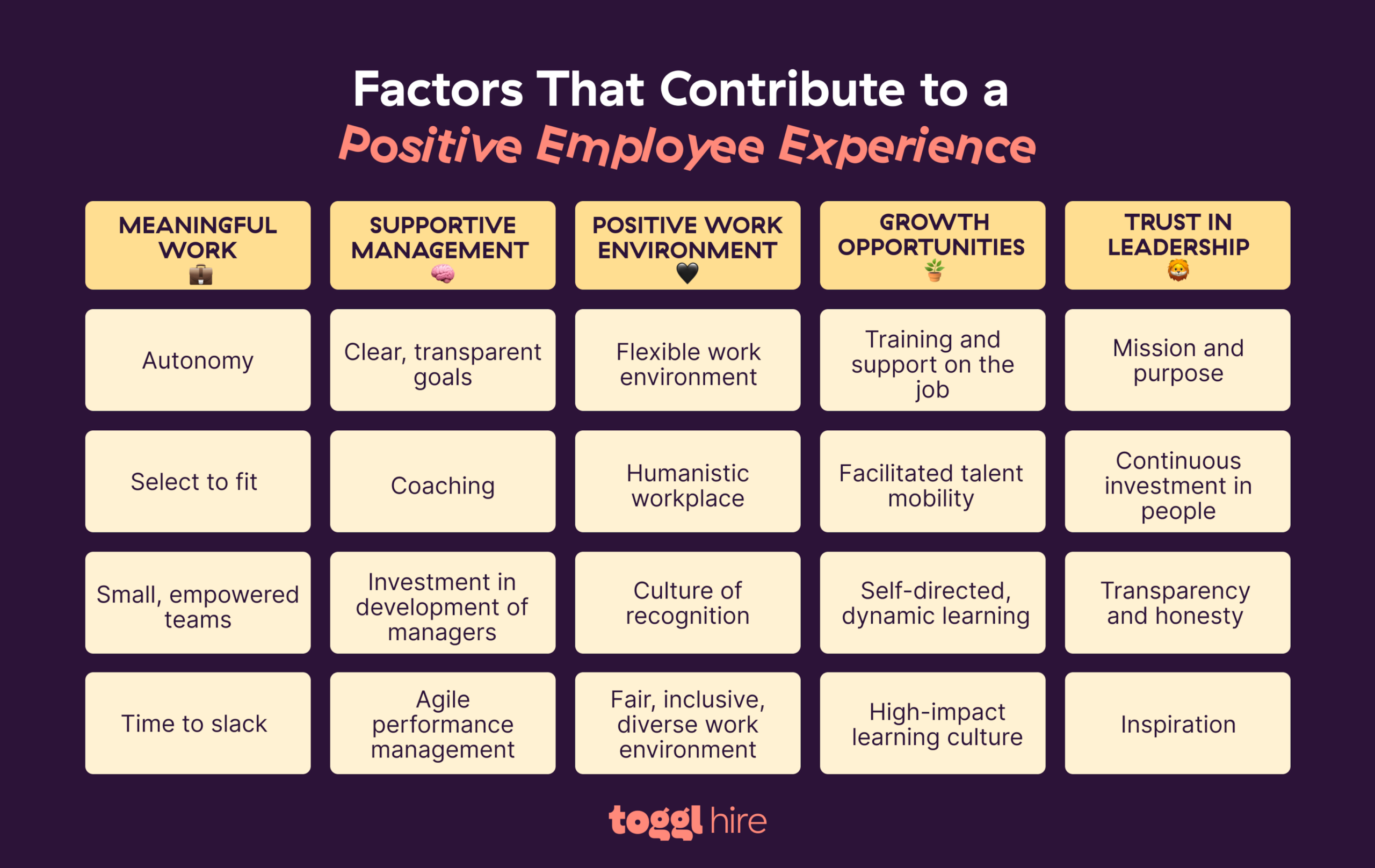The labor market never sits still, so every year, we’re challenged with new recruitment trends. While it might feel exhausting trying to keep up, understanding what’s happening on the market (and why) is the only way to improve your hiring strategy.
From gaping skills gaps to shifting employee preferences regarding remote and hybrid work, let’s first recap the impact of top hiring trends of the past few years on today’s market — then analyze what’s on the agenda for 2025.
Key shifts in the recruitment market in 2024
2024 was a year of recalibration in the labor market.
Amid economic uncertainty, layoffs in the tech sector persisted, with companies restructuring to focus on profitability. Companies like Tesla, Microsoft, Amazon, TikTok, Snap, and Google all made cuts, with the industry losing around 130,000 people across 457 companies.
A similar story exists in the financial services sector, where the top 12 investment banks slashed 100 front-line dealmakers in Q1 of 2024 alone.
You’d imagine, then, that the talent market would be filled with highly skilled people, ready to slide into place at other organizations. In the case of bankers, this appears to be the case. Eric Li, research director at Coalition Greenwich, explains:
Investment banks remain laser-focused on costs. What we’ve seen is that while the big banks are cutting, smaller boutiques and other investment banks are picking them up. Around 60 of those who lost their jobs have found new roles elsewhere. It’s a great chance for them to pick up talent that would otherwise be too expensive to hire.
However, many other industries report that skill shortages have made it challenging to find the caliber of candidate they need to fill their open vacancies. SHRM’s Talent Trends report reveals that over three in four organizations have had difficulty recruiting for full-time regular positions. Highly skilled medical positions and skilled trades have been the most difficult-to-fill positions in 2024.
One in four organizations indicate full-time regular positions filled in the past 12 months demanded new skills. Organizational growth (55%) and evolving technology (51%) are the primary drivers of these new skill requirements. However, three out of four organizations report facing moderate to significant challenges in finding candidates with the necessary skills.
Talking of skills challenges, SHRM also finds that 37% of candidates don’t have the required technical skills, 30% lack adequate soft skills, and 18% don’t even have the basic skills needed to join their organization.
At the same time, some traditional hiring incentives are being scaled back. For example, the percentage of organizations offering flexible work arrangements has reduced by 16% in 2024 compared to 2022. Improvements to compensation packets, including salary and employee benefits, also fell by 16%. These declines highlight a move away from some of the more generous pandemic-era recruitment strategies, even as the need for top talent remains.
So, what do companies have up their sleeve to deal with these gaps in their organizational lineup?
Top recruitment trends to expect in 2025
Effectively, last year’s recruiting trends serve as a springboard for the new developments in the market. So, here’s what we expect to see through 2025.
1. The evolution of AI adoption
Hirers and job seekers have moved beyond the excitement of artificial intelligence’s arrival and are now experiencing it as a mainstay of the recruitment process. Some 57% of applicants relied on OpenAI during the application process in 2024 (which is hardly surprising) either to speed up or refine their applications.
Professional resume writers, job coaches, and other online tools have been around for decades. AI is just another version of the same. So, well-trained HR managers are well aware that the resumes they’re reviewing may not have been written by the candidates (and that’s one reason why Toggl eliminated resume screening long ago).
The lesson here? To hire top talent in the age of AI, you need to adapt your recruiting process.
Instead of giving candidates problems ChatGPT can solve, try testing their skills with open-ended homework assignments or soft skills assessments. Modern assessment tools like Toggl Hire include anti-cheating and anti-AI protection, which also prevents candidates from using apps during tests.
In a world where everybody is using AI to boost productivity and improve efficiency, it might seem “wrong” to prevent candidates from using AI to help them apply for your job listings. However, doing so allows you to assess the candidates’ actual skills and personality traits rather than evaluate how well they can use ChatGPT to look up the right answers.
It’s not all about preventing AI usage, though. Hiring teams are also exploring ways to use AI for good in the hiring process. For example, T-Mobile relies on an AI-powered tool to remove biased, non-inclusive language from job descriptions.
New HR technology, powered by advanced algorithms, can help hiring teams:
- Streamline repetitive, manual tasks such as interview coordination and scheduling, ad publishing to multiple job boards, satisfaction survey management, new hire onboarding, employee payroll management, and more.
- Create automated communication channels to both strengthen employer branding and improve candidate experience. Thanks to natural language processing (NLP), chatbots can easily provide candidates with updates on their application status, answer questions about company culture, and handle a ton of other recruitment marketing activities.
- Automate document processing. Artificial intelligence can document cross-checks and information lookups at cruising speed with high accuracy. Streamline candidate identification and document checks with new KYC tools. Save time with AI-generated summaries of new regulatory or compliance documents.
- Get more data for decision-making. Whether you’re doing workforce planning for the new year or trying to evaluate your diversity, equity, and inclusion (DEI) metrics, AI can crunch the numbers. Thanks to predictive analytics, you can also look into the future and model the volume of future applicants or estimate talent attrition using historical data.
- Build bigger talent pools. Leverage AI to cross-check past candidates’ or current employees’ skills and match them with new job opportunities. Personalize outreach to potential prospects on social media and across job boards to get more people into your recruitment funnel.
AI already has ample practical use cases in recruiting, and we expect more talent leaders to embrace it by 2025.
Practical tips for making better use of AI in recruitment
- Learn about the different types of AI. Machine learning, predictive analytics, generative AI, and robotic process automation (RPA) — each of these technologies is better suited for specific tasks in a recruiting process. For example, Generative AI excels in content generation, while predictive analytics helps with advanced forecasting and modeling.
- Brainstorm use cases. Identify the most time-consuming, error-prone, and manual elements of your talent acquisition process. Brainstorm with hiring managers how different AI products can address the inefficiencies.
- Start with pilot projects. Select several test use cases. For example, test different AI apps for recruitment marketing tasks or employer branding activities (e.g., job ad copy generation or personalized nurturing sequences for candidates in your pipeline). Set clear success criteria for each and measure the impact to estimate ROI.
2. Increased commitment to skills-based hiring
As the cost and time-to-hire increase, every new employee becomes a critical hire. The increased emphasis on talent quality will require companies to tighten the recruitment process. Hiring managers will be eager to vet job seekers more rigorously and at a wider scale with the help of skills-based hiring.
For 78% of HR professionals, SHRM reports that pre-employment assessments, which test skills, knowledge, and abilities, have improved the quality of their organization’s hires. 80% of recruiting pros claim to be committed to creating a more diverse workforce, and a skills focus is central to this initiative. Note: A skills focus increases talent pools by 10x, according to LinkedIn.
That’s because skills-based recruiting moves away from basing hiring decisions on gut feelings toward actual data on candidates’ competency. You can practice collaborative hiring by giving each manager the power to select people with the skills they need.

Design custom assessments using expert-made questions from our test database featuring role-specific and skill-specific tests. If your goal is to build a more competent and diverse workforce in 2025, skills-based hiring is the way to go.
Practical tips for implementing skills-based hiring in 2025
- Conduct a job task analysis to better understand the role’s competencies. Shift the focus from degree or work experience requirements to the skills, qualifications, and aptitudes of an ideal hire.
- Determine the optimal use cases for pre-employment tests. Use basic skill tests to quickly check if applicants have the skills needed. Then, apply a combination of different interviewing methods and take-home assignments (case studies, coding challenges, language tests, time-boxed competency assessments) to find the perfect skill matches.
- Drop questions about the candidate’s background to eliminate interviewer bias. Instead, ask more behavioral and problem-solving questions to understand how a candidate thinks and acts rather than what shaped them personally and professionally. By combining structured interviews with pre-employment tests, you can get a more comprehensive picture of a candidate’s skill set and team fit.
3. Strong labor market optimism
Prepare for the labor market to open back up again in 2025. Although the current unemployment rate in the US is expected to remain around 4%, and a stable 6% in the EU, more opportunities will exist.
Over 80% of employers across tech, financial services, and healthcare plan to expand hiring in 2025, signaling renewed labor market optimism after two years of declines. Easing inflation and stabilizing interest rates are fueling employer confidence. 64% say macroeconomic conditions will support hiring in 2025.
Julia Pollak, ZipRecruiter’s Chief Economist
At the same time, EY reports 38% of employees are likely to quit in the next year due to poor pay and work-life balance.
For recruiting professionals, the above trends translate to a bigger talent pool…and bigger workloads, too. With an increased supply of candidates and an increase in open roles, there will be a heck of a lot of movement. Recruiters can expect to spend more time wading through hundreds of applications, pre-screening for hard skills, and scheduling rounds of interviews.
And without a strong talent acquisition strategy, you risk getting some bad hires on board.
Skills assessments can help hiring teams quickly find the most suitable candidates. Sadly, many job seekers lack essential hard and soft skills for the jobs they are after. That’s where proof of competence will become synonymous with recruiting top-level talent.
Skills assessments can help hiring teams quickly whittle down the initial flood of applicants and highlight the most suitable candidates. AI for process automation, in turn, can help with secondary hiring processes (background checks, job offer management, onboarding, etc.), helping you reduce time-to-hire and boost productivity.
Practical tips for managing your candidate pipeline in 2025
- Refresh job descriptions with new skills to better reflect the kind of talent you’re seeking for vacant positions.
- Be upfront about non-negotiable criteria. State if the role doesn’t support remote working or is strictly limited to candidates from a specific location.
- Combine different pre-screening methods like resume checks, competency assessments, cognitive abilities, and aptitude tests (among others) to get more qualified candidates to the next stages.
- Use cultural fit interviews and job simulations to secure both proof of competence and a strong team fit.
4. Increased focus on closing skills gaps
Although the overall candidate supply is higher this year, skill shortages aren’t going away. Digital transformations, an aging workforce, a decreasing number of STEM graduates, and lower participation among women negatively affect today’s labor market.
Since 2015, the skill sets for jobs have changed by 25%, and that number is expected to be 65% by 2030. Yet, both existing employees and active job seekers are behind in developing new competencies.
Modern-day jobs also require softer skills. As AI advances, businesses need to balance robotic output with human instincts, making interpersonal skills highly sought-after.
The most in-demand skills? Here they come:
- Communication
- Customer service
- Leadership
- Project management
- Management
- Analytics
- Teamwork
- Sales
- Problem-solving
- Research
Talent upskilling and reskilling will be a major recruiting trend in 2025.
To address the problem, HR leaders will need to first gain visibility into existing organizational skill gaps and evaluate the effects of tech disruption on the existing roles.

Practical tips for addressing skills gaps in 2025
- Schedule a talent gap analysis to deconstruct the work your people already do and the skills they have (and lack) to perform their jobs better. Identifies areas for strategic recruitment, training, and development.
- Introduce career coaching sessions. Improve employee engagement and talent retention by introducing new professional development plans for employees and walking them through different training programs available.
- Offer a training budget. Instead of superimposing training from above, let employees choose any professional training, workshop, or conference they fancy. At Toggl, we give each employee €4K annually as part of our benefits program, and this helps us maintain a highly skilled workforce.
- Launch an apprenticeship program. Expand your campus recruiting program with a digital apprenticeship — a fixed-duration program aimed at teaching fresh grads suitable hard skills.
5. Using contractors to plug operational gaps
Since 2020, business leaders have been increasingly turning to contingent, seasonal, or consultant employees to address skills gaps, better respond to changing market conditions, and maintain a competitive edge.
In fact, Robert Half’s State of US Hiring report finds that 63% of companies plan to add contract professionals in the first half of 2025.
Contingent labor is expected to comprise 35% to 40% of the global workforce by 2025.
Gartner
This trend translates to extra workloads and complexities in compliance management for recruiting teams. Faster hiring cycles, proper worker classification, rapid onboarding (and offboarding) — a lot of grunt work is required to maintain a contingent workforce.
To streamline external workforce management, create a set of processes, projects, or roles you want to fill in with contractors and map these to anticipate engagement duration. Determine:
- Which roles have temporary or fluctuating demand?
- Which roles are need-driven?
- Which roles require long-term support?
Instead of standard job descriptions, highlight specific job tasks that contractors will need to complete (e.g., produce three blog posts per month) or processes you’d want them to handle (e.g., payroll management).
Finally, don’t forget about compliance. Be upfront about any specific requirements you have — mandatory liability insurance, a valid professional license, the ability to perform on-site work, and so on.
You will need to change your hiring strategy to recruit and onboard contractors. But the payoff of doing so is greater operational agility, faster hiring cycles, and easier access to in-demand skills.
Practical tips for hiring contractors in 2025
- Understand the different service models. Some contractors do mostly deliverable-based, fixed-price gigs. Others prefer retainers, charge hourly for fractional engagements, or take a day rate for consulting work. Check if your current accounting setup can accommodate their proposed payment cycle and payment terms.
- Rely on social media recruiting. Contractors and freelancers don’t frequent popular career sites. Instead, they hang out in online communities and on social media. Prioritize LinkedIn and Twitter to build relationships with independent workers.
- Offer fair compensation. Contractors save companies a lot of payroll costs since most taxes are passed on to them. This means few can (or will) afford to charge the same hourly rates as regular employees. Don’t lowball the proposed rates, and try to negotiate the scope of work instead if you have budgetary constraints.
6. Employee engagement is in crisis mode
Over the past years, we’ve seen the Great Resignation, Quiet Quitting, Quiet Firing, and Rage Applying. That’s hardly surprising, given that employee engagement has been sinking year-over-year.
Evaluating employee engagement is a top priority for HR professionals in 2025.
Rising cost of living, salary freezes, forced returns to the offices — a lot of factors have made the global workforce less optimistic about the future.
The latest recruiting trends, including increased reliance on contingent talent, accelerated adoption of AI, and the return of a recruiter’s market, are making people even more anxious about their job security.
To patch things up in 2025, HR professionals will need to first evaluate the job satisfaction scores and then drill down to the causes of poor engagement.
Collect feedback on all levels:
- Survey managers about their levels of happiness, motivation, and recognition, plus their perception of the team’s morale and satisfaction.
- Ask lower-level employees to anonymously share feedback about their managers. Do they get enough recognition, timely feedback, and the ability to bring up new ideas?
Compare the sentiments to better understand the gaps and overlaps in perception and determine the best course of action.
Practical tips for improving employee engagement in 2025
- Coach your managers to lead better. Middle managers are responsible for 70% of the variance in employee engagement. Identify leaders with strong people skills (and likely higher team engagement scores!) that you already have and look to hire more people with similar skill sets for open roles. Invest in extra training for current staff to help them develop better soft skills, curb micro-management tendencies, and learn some new ways to empower and recognize their employees.
- Advocate for employees’ ideas. Don’t just ask for feedback; act on it. Create a transparent system for accepting, evaluating, and executing employee ideas. Show that your company listens, cares, and implements suggestions from people at every level.
- Double down on your remote and hybrid policies. 34% of businesses plan to extend their return to office policies to five days a week in 2025. But this doesn’t mesh well with employees who value a more flexible working model. 60% of employees would stay in a job they hate if it offered flexible hours, and 22% would quit their employer if it enforced an RTO mandate. If remote-first isn’t the right fit for your organization, consider the more flexible hybrid approach, which could be a gamechanger for your employee engagement levels.
7. Internal mobility is on the rise
The recruiting landscape will remain dynamic, with people moving internally and even cross-border to keep progressing. And by offering this, employers can hang onto their top talent and avoid the expense of recruitment. KornFerry finds that 67% of internal employees would remain with their employer if they received adequate opportunities for upskilling and advancement.
As costs continue to soar into 2025, sourcing talent from within an organization can be a first step in saving expenses during the recruitment process. Hiring talent internally and promoting talent mobility schemes not only helps save on recruitment expenses like interviewing candidates and working through agencies but it also helps convey business confidence in existing employees’ skills while also providing current staff career growth and development opportunities.
Julia Braun, Chief HR Officer for software provider, SoftwareOne

A tough job market, combined with sinking employee engagement rates, means that businesses will likely be forced to keep flexibility on the agenda. However, these recruitment trends allow for hiring more diverse candidates, optimizing operating costs, and increasing corporate resilience.
When done right, a strong internal mobility strategy helps close the knowledge and skills gaps, improve employee engagement rates, and minimize the impact of local labor shortages on business operations.
Create a strong internal mobility strategy to boost employee engagement rates.
Practical tips for improving your talent mobility strategy in 2025
- Brainstorm new talent mobility opportunities. Instead of only moving talent geographically or vertically up the career ladder, consider alternative schemes: lateral moves to other teams or projects, job shadowing or mentorship to support cross-function mobility, and virtual “experience exchange” assignments. The current state of technology allows you to effectively combine in-person and virtual collaboration across functions.
- Create a dedicated internal hiring process. Don’t force existing employees to go through the same process as any other job seeker. Streamline and simplify the application process by using competency assessments rather than resume pre-screening and peer interviews instead of culture pre-screeners with HR.
- Mind compliance. Work-from-anywhere arrangements come with a new pane of tax, immigration, and employment law risks. New remote work-related tax rules may also emerge. Ensure that your policies remain in close sync with the current compliance regulations to avoid unnecessary risk exposure.
8. Talent retention remains a top priority
Telenet retention is an important part of workforce planning, and even more so in 2025 as the wave of resignations continues. 90% of organizations are concerned about retention, according to LinkedIn’s Workplace Learning Report. They consider “offering learning opportunities” as the top retention strategy.
According to employee recognition platform Nectar, 29% of employees have quit a job within the first 90 days of starting. Clearly, HR teams need to focus more on improving the candidate experience and employee experience.
To do better in 2025, focus on addressing the necessities. Poor compensation is the top reason for candidates seeking a role elsewhere, which makes sense given the economic climate.
But if cash bonuses and pay bumps will strain corporate cash flow, prioritize alternative options. To improve talent retention and engagement, career progression and work flexibility could also persuade your employees to stay, according to the Achievers Engagement and Retention report.
You can also consider other non-cash perks like more personal time-off, tenure-based sabbaticals, flexible time-off (like we have at Toggl!), catered weekly lunches, etc.
Introduce greater pay transparency to avoid the unwarranted negative sentiment some employees may harbor. On average, an increase in pay transparency levels can also boost employee retention rates significantly, according to iMercer.
Switch from proactive recruiting to proactive talent nurturing to ensure that your best hires are motivated to do their best work for your company, and not to look for a new job.
Practical tips for retaining top talent in 2025
- Refresh your succession plans. Look into creating new vertical and horizontal growth opportunities for experienced employees. Standardize performance reviews and industry benchmarks to make compensation offers more competitive. Use data-backed KPIs to clearly set performance expectations and recognize the best candidates for promotion.
- Introduce better perks. 87% of employees would consider leaving a company that does not focus on their wellbeing, and perks are an important part of supporting them. With inflation rising, fewer people appreciate fancy gym memberships or having access to an in-office meditation room. Among the most in-demand employee retention perks for 2024 were lifestyle spending accounts that allow workers to spend a fixed monthly allowance on benefits meaningful to them. For example, health and well-being support, family care (sponsored daycare, elderly care), adoption assistance, catered food, and better work-from-home support.
- Improve the workplace ambiance. Mass layoffs, budget cuts, workplace automation — a lot of the latest recruitment trends make employees wary about their job security. Combined with a tougher leadership style, these factors dramatically reduce the employees’ comfort with taking risks and making mistakes without fear of negative consequences. Only 58% of workers feel psychologically safe at work and, by proxy, less engaged and productive. Measure how your company performs in the area of psychological safety and implement better practices like a “no-blame culture” and “fail fast-learn fast.”
Stay ahead of recruitment trends in 2025
From the growing importance of employee engagement to skills-based hiring, the latest recruiting trends for 2025 feel more like an evolution of effective HR practices than a revolution in hiring. And that’s a relief, right? Sure, but it’s definitely not a sign to kick back and relax because the job market will be anything but steady this year.
Sync with new candidates and current employees’ expectations to avoid higher talent attrition. Empower your hiring team with AI tools that simplify and automate the recruitment process. Evaluate how contingency workforce and new talent mobility models can help you address skills gaps.
If improving the quality and speed of hires is your priority for 2025, check out our skills-based hiring pipeline that helps screen, shortlist, and hire the most qualified people for the job. Get started for free!
Rebecca has 10+ years' experience producing content for HR tech and work management companies. She has a talent for breaking down complex ideas into practical advice that helps businesses and professionals thrive in the modern workplace. Rebecca's content is featured in publications like Forbes, Business Insider, and Entrepreneur, and she also partners with companies like UKG, Deel, monday.com, and Nectar, covering all aspects of the employee lifecycle. As a member of the Josh Bersin Academy, she networks with people professionals and keeps her HR skills sharp with regular courses.










